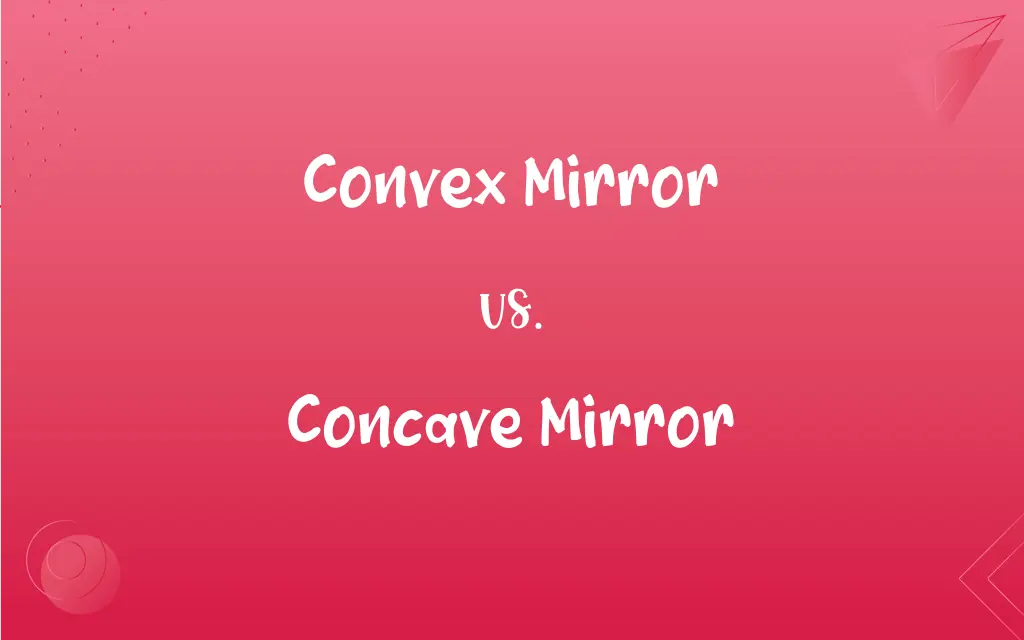Convex Mirror vs. Concave Mirror: What's the Difference?
Edited by Aimie Carlson || By Harlon Moss || Updated on July 12, 2024
A convex mirror bulges outward, giving a wider field of view and producing smaller, diminished images. A concave mirror curves inward and can produce magnified or inverted images depending on the object's distance.

Key Differences
A convex mirror is a curved mirror in which the reflecting surface bulges outwards. This outward bulge means that it diverges light. Typically, convex mirrors are used in situations where a broader field of view is required, such as in vehicle side mirrors. A concave mirror, in contrast, is a curved mirror where the reflecting surface caves inwards. Due to its inward curve, it converges light. One of the primary uses of a concave mirror is in telescopes and makeup mirrors.
Both convex mirrors and concave mirrors play crucial roles in optics and have diverse applications. While convex mirrors help drivers see more of the road behind them, concave mirrors aid in focusing light, making them useful in devices like torches and headlights.
Convex mirrors, due to their outward curvature, always produce virtual, erect, and diminished images. On the other hand, concave mirrors can produce both real and virtual, erect or inverted images based on the distance of the object from the mirror.
In essence, the key distinction lies in the curvature. Convex mirrors have an outward curve and diverge light, while concave mirrors have an inward curve and converge light.
Comparison Chart
Surface Curve
Bulges outward
Curves inward
ADVERTISEMENT
Light Behavior
Diverges light
Converges light
Image Produced
Always virtual, erect, and diminished
Can be real/virtual, erect/inverted based on object distance
Common Uses
Vehicle side mirrors, security cameras
Telescopes, makeup mirrors, headlights
Focus
Light rays diverge and never meet
Light rays converge and meet at a focus point
Convex Mirror and Concave Mirror Definitions
Convex Mirror
A mirror that always forms virtual and diminished images.
Using a convex mirror, the security guard could see the entire store.
ADVERTISEMENT
Concave Mirror
A mirror that can form both real and virtual images.
With the candle close to the concave mirror, the image was magnified and upright.
Convex Mirror
A mirror with an outward-curved reflecting surface.
The car's side-view is a convex mirror, offering a broader view of the road.
Concave Mirror
A reflective surface that converges light.
The concave mirror in the torch focused the light into a beam.
Convex Mirror
A mirror used to capture a wider field of view.
The store's convex mirror allowed customers to see all the available products.
Concave Mirror
An inward-curving mirror used in telescopes.
The observatory's large concave mirror gathered light from distant stars.
Convex Mirror
A reflective surface that diverges light.
In the mall, they placed a convex mirror at the corner to prevent collisions.
Concave Mirror
A mirror with an inward-curved reflecting surface.
The makeup artist used a concave mirror to see the details of her work.
Convex Mirror
An outward-bulging mirror commonly used in vehicles.
To see the blind spots, drivers rely on the convex mirror.
Concave Mirror
A mirror capable of producing magnified images.
The dentist used a concave mirror to get a better look at the patient's teeth.
FAQs
What's a common use for concave mirrors?
They're frequently used in telescopes and makeup mirrors.
Where are convex mirrors typically used?
Convex mirrors are commonly used in vehicle side mirrors and security cameras.
What is a concave mirror?
A concave mirror is a mirror with a surface that curves inward.
Why do vehicles use convex mirrors?
To capture a broader field of view.
How do concave mirrors reflect light?
Concave mirrors converge light.
Can concave mirrors produce magnified images?
Yes, when the object is close.
Can a convex mirror form an inverted image?
No, it always forms erect images.
How do objects appear in a convex mirror?
Objects appear smaller and farther away.
What's the focal point of a concave mirror?
Where converged light rays meet.
How do objects appear in a concave mirror?
They can appear magnified or diminished, depending on the distance.
Why are concave mirrors used in headlights?
To focus the light into a beam.
What's the focal point of a convex mirror?
The point where diverged rays appear to originate.
What is a convex mirror?
A convex mirror is a mirror with a surface that bulges outward.
How do convex mirrors reflect light?
Convex mirrors diverge light.
What type of images do convex mirrors produce?
Always virtual, erect, and diminished.
Can a concave mirror produce both real and virtual images?
Yes, depending on the object's distance.
Are convex mirrors used in telescopes?
No, concave mirrors are preferred for telescopes.
Why are concave mirrors called "converging mirrors"?
Because they bring light rays together.
Which mirror is used in shaving or makeup mirrors?
Concave mirrors, as they magnify the image when close.
Why are convex mirrors called "diverging mirrors"?
Because they spread light rays apart.
About Author
Written by
Harlon MossHarlon is a seasoned quality moderator and accomplished content writer for Difference Wiki. An alumnus of the prestigious University of California, he earned his degree in Computer Science. Leveraging his academic background, Harlon brings a meticulous and informed perspective to his work, ensuring content accuracy and excellence.
Edited by
Aimie CarlsonAimie Carlson, holding a master's degree in English literature, is a fervent English language enthusiast. She lends her writing talents to Difference Wiki, a prominent website that specializes in comparisons, offering readers insightful analyses that both captivate and inform.































































